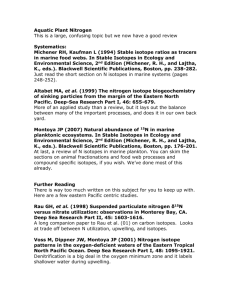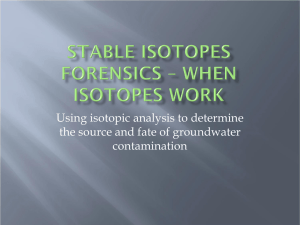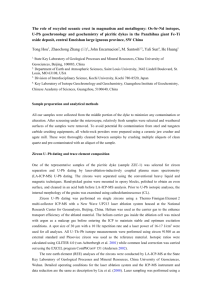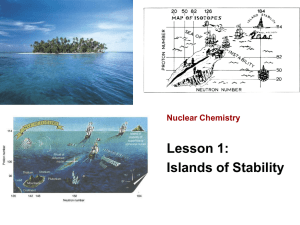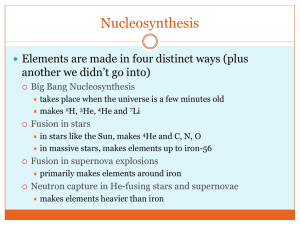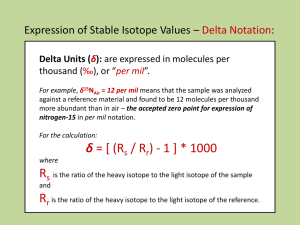Isotope Hydrology
advertisement
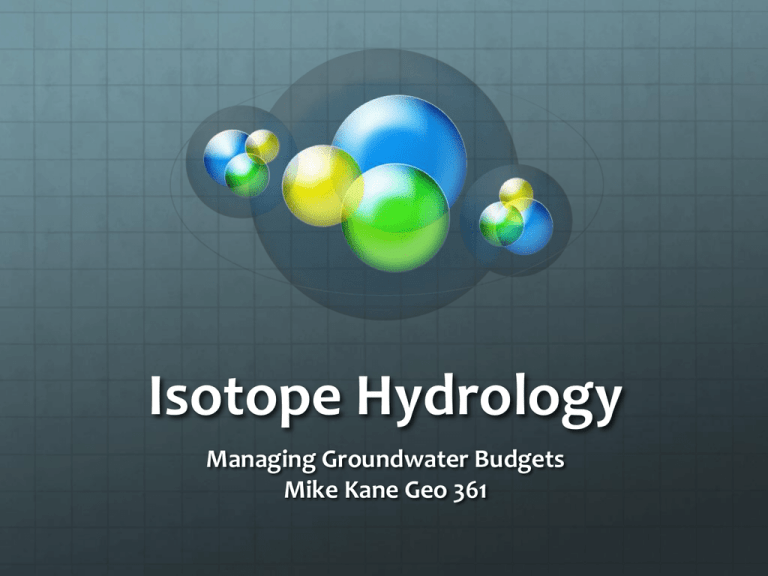
Isotope Hydrology Managing Groundwater Budgets Mike Kane Geo 361 What is Isotope Hydrology? Isotope Hydrology is a nuclear technique that uses isotopic dating to measure and estimate the age, origins, and the movement of water within the hydrologic cycle. The isotopes in water can be traced through water sources to determine where the source is, how it is recharged, and if it is at risk of contamination. Why Use Isotope Hydrology? Of all the water on Earth about 2.5% of it is freshwater sources. Most of this water is locked in the icecaps, in soil moisture, or in deep underground aquifers. Water is key for the development of life. According to the IAEA about 1/3 of the global food comes from irrigation, which requires sustainable groundwater sources. About 1.1 billion people today go without fresh water and in 2025 2/3 of the world’s population may live in countries with high shortages of water. How Isotope Hydrology is Used During the processes of ET and condensation the oxygen and hydrogen isotopes in water molecules begin to undergo changes. When water is passed around in the Hydrologic cycle it becomes naturally stamped with “isotopic fingerprints”. These finger prints vary depending on the body of water and how the water molecules travel through out the cycle. The isotopes of the atoms are chemically identical but physically different. For example Oxygen becomes split into Oxygen 16 and Oxygen 18 isotopes. Certain isotopes have a heavier nuclear weight which allows them to be distinguished from other isotopes. Oxygen 18> Oxygen 16. How Isotope Hydrology is Used Cont. When ocean water evaporates, heavier isotopes will condense and precipitate first. Since most evaporation occurs over the ocean, the rain furthest from the coast will be less enriched with heavier Isotopes. As water changes stages in the hydrologic cycle the composition of water isotopes will vary. With the different isotopic signatures occurring, this allows hydrologist to map groundwater sources and to determine how they gain/lose water by following the trail isotopes. Application of Isotope Hydrology Lake Chala is a volcanic crater that’s on the southeastern slope of Mt. Kilimanjaro. Lake Chala has an area of 4.2 km2, a volume of 3 X 108 m3, and a depth of 100 m. Lake Chala is not subject to surface inflow or out flow. During the 1960’s this lake became of interest when local farmers were looking for more sources of water to expand their irrigation processes. Application Cont. A problem arose because of nearby underground springs that were already in use for irrigation purposes. No one knew if the lake was the source of water for the springs and by taking water from the lake could effect the amount of water in the springs. To determine if the two water sources were connected 10 water samples were taken from the lake on two occasions nine months apart. Over the course of three years samples were taken from the local springs. O18 (0/00) σ D (H2) (o/00) σ Lake Chala 1967 2.51 .07 7.3 2.7 Lake Chala 1968 2.43 .16 4.9 4.4 Homer Spring -3.96 .05 -20.5 2.8 Kileo Spring -4.72 .08 -23.2 1.3 Lenoya Spring -4.11 .43 -17.3 1.9 Little Lumi Spring -4.20 .21 -18.3 .9 Magi ya Waleni Spring -3.97 .20 -17.2 2.1 Njoro Kubwa -4.05 .43 -19.4 2 Njoro Ndogo -4.04 .24 -18.6 2.1 Latema Borehole -4.53 .14 -22.1 3.1 Kitovo Spring -4.56 .21 -21.9 2.6 Application Cont. Proven by the data table, the composition of isotopes O18 and D (H2) didn’t vary with time. The values for the isotope composition of Lake Chala and the nearby springs were greatly different. This means that the lake water had no connection with water from the springs. Conclusion Isotope hydrology is a useful tool in helping countries and people develop water management strategies. It is very cost effective way to assess the location of groundwater, where it is being recharged and help decisions on where to extract the water. The IAEA has put in over 30 million dollars in 150 projects to help 60 countries develop water management strategies and techniques.
